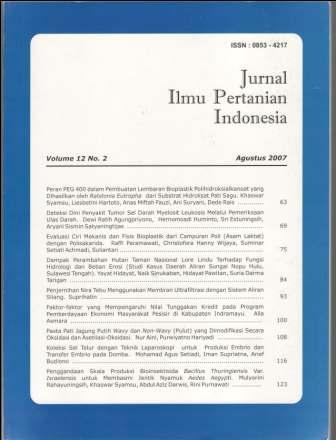Peran PEG 400 dalam pembuatan lembaran bioplastik polohidroksialkanoat yang dihasilkan oleh Ralstonia eutropha dari Substrat Hidrolisat Pati Sagu
Abstract
The purpose of the research was to investigate the effects of PEG 400 addition on the characteristics of bioplastic polyhydroxyalkanoates (PHA). PHA was obtained by cultivating Ralstonia eutropha on hydrolysed sago starch substrate using fed batch method for approximately 96 hours. The biomass concentration obtained was 4 g/L with PHA yield 20-30% of dry cell weight. The bioplastic was formed with solution casting method in which chloroform was used as solvent and PEG 400 was used as plasticizer. The concentrations of PEG 400added were 10, 20, and 30% (w/w), respectively. Bioplastic properties which were tested were tensile strength, elongation to break, density, thermal properties, cristalinity, and functional group. The addition of plastisizer tend to increase tensile strength and elongation to break, but decrease density, cristalinity and melting point. Bioplastic with 30% PEG 400 addition gave the best results. Bioplastic with 30% PEG 400 gave a value of tensile strength of 0.083 MPa; elongation to break of 0.881%; density of 0.7881 g/cm3; melting point of 158.95 ac; and cristalinity of 44.58%. With these properties, the resulted bioi plastic may be used for surgical strings. Keywords: Bioplastic, Polyhydroxyalkanoates (PHA), Ralstonia eutropha, hidrolysed sago starch, PEG 400Downloads
This journal is published under the terms of the Creative Commons Attribution-NonCommercial 4.0 International License. Authors who publish with this journal agree to the following terms: Authors retain copyright and grant the journal right of first publication with the work simultaneously licensed under a Creative Commons Attribution-NonCommercial 4.0 International License. Attribution — You must give appropriate credit, provide a link to the license, and indicate if changes were made. You may do so in any reasonable manner, but not in any way that suggests the licensor endorses you or your use. NonCommercial — You may not use the material for commercial purposes.



















